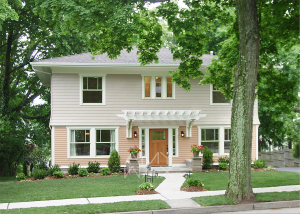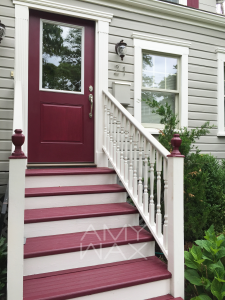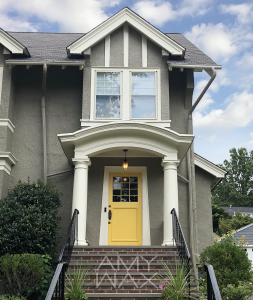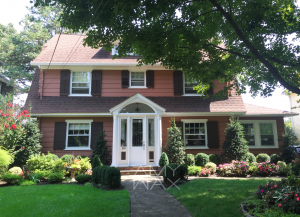
While many people feel strongly opinionated about what color palettes should be used within their home’s interior, the home’s exterior proves to be a much bigger challenge.
Is it the fact that the exterior of the home is representing you to your surrounding neighbors and the town you live in? Choosing exterior color palettes is a real challenge for many homeowners; you are not alone. I believe that it’s a greater mental hurdle for homeowners to pick out exterior color schemes because these colors are so visible to others.
While it is absolutely a large undertaking, it’s not beyond your ability to discover an exterior color scheme that is truly inspired!
It is an exterior paint color consultant’s job to work with you to discover the colors that best suit your home. In this article, I’m going to provide you with some insight and tips to help you find exterior color schemes and options that you would be proud to show off to the entire neighborhood.
However, more importantly, my goal is to help you discover color palettes that make YOU happy and express your unique tastes as a homeowner.
The right exterior paint colors can elevate any home to increase curb appeal and be the neighborhood standout. Now, this doesn’t mean that you must choose the most eye-catching colors available to you.
No, what I mean when I say elevate your home’s presence is make it known that your home is fully invested in the colors it’s presenting to the world.
Make it known that each exterior color was chosen with care and attention to detail. Whether your home is better suited for outside paint colors that are more traditional or energized and contemporary, it’s paramount that the presence of your color schemes doesn’t seem accidental or merely trendy.
Whether your home is a Colonial, Cape Cod style, or Ranch style traditional home, they are almost always best suited for simple color palettes that create an inviting and distinguished presence. Find inspiration from simple, elegant and classic design when choosing your exterior color schemes for your traditional home.
For a neutral color palette, try colors that are soft stone colors as an effective and popular choice for the siding (body color); this could be an off-white, taupe or muted gray whether it is light or dark. This sets an excellent foundation to layer inspired color choices on top of.

I suggest choosing a color for the body of your home that takes the neutral palette and pushes it just a bit. That means that rather than choosing a gray, choose a slate blue/gray or maybe even a gray/green. Rather than choosing a taupe, try a terra cotta. Another options is rather than choosing a color that is an off white, go a little warmer with a creamy white or even a lighter taupe, or soft brown. These body colors are like adding a color to the neutral palette you started with, making it that much better!
The shutters, overhangs, windows, banisters all share an opportunity to create some contrast and definition to a traditional home. Using darker colors such as navy blues, blacks, or a hunter green, elevates a traditional-style home’s color scheme making it interesting and dynamic, but not tasteless and tacky.
 Finally, the front door is an opportunity to interject an accent color that is alive and statement worthy. A deep red is a great choice for your traditional-style front door. although a bright yellow can certainly make a bold statement!
Finally, the front door is an opportunity to interject an accent color that is alive and statement worthy. A deep red is a great choice for your traditional-style front door. although a bright yellow can certainly make a bold statement!

Contemporary homes and modern architecture take a more minimalist approach todesign and presence.
Of course, this can depend on the region in which you live. But, generally speaking, contemporary homes ditch the standout architectural features that defined many traditionalist homes of the past.
Traditionalist features such as uniform symmetry and centralized doors & chimneys have been largely excluded from modern design. Modern homes tend to have greater subtlety and chicness, which can often come across as cold and unwelcoming if the color schemes are not chosen to counterbalance this.
Contemporary homes look stunning when using neutral color schemes that collectively pack a punch. What do I mean by this? For example, a single-story home with exposed wood and stucco exterior walls may use the color scheme of light gray, copper and pale olive green. For this style of architecture, you might also try a darker palette of charcoal gray, a midnight blue/black, or an espresso brown. Richer colors might give you the dramatic statement you are looking for!
These are all neutral colors, but collectively they create an unforgettable color scheme that is both tasteful and inspired by earth tones.
In the 1980s and 1990s, an ultra-contemporary home would be nothing but vibrant whites and marble, which was nice at the time. But, today’s exterior color schemes can bring more vibrancy, life and warmth to a home’s exterior without looking out of place or disjointed.
A home is a combination of surfaces, and every surface deserves a little attention. Most homes require at least four colors to accentuate all the details, which is not a lot! Looking at the photo above, I have the body color, shutter color and trim color, a basic palette starting with three colors. I will show you why adding the fourth color makes a big difference!.
There is a fourth color, in this case, for the first floor of the house, but if you do not have a home that requires two body colors, you might need a color for the foundation. Perhaps you will want a different colored front door, or you might even want an accent color for window boxes or planters!

Suddenly, four colors don’t seem so far-fetched! Create the color palette for your home with at least three, most likely four colors, and it will give your home more curb appeal and personality!
With all my years of experience working with homeowners, many people often don’t know where to start. They often ask me what style of home do I have? Do I have to pick colors that compliment the time when my home was built? I often hear, ‘I don’t think my home is either traditionalist or contemporary; where does my home fit into these schemes?”
Don’t fret. EVERY home has the opportunity to showcase a beautiful color scheme that is unique unto its own. Ultimately you should choose colors you love, regardless of the time when your home was built or the style of the home.
Although I showcased some foundational ideas for exterior color schemes, they are not a doctrine for every homeowner to follow. If you are looking for inspiration, learn about your home’s history. Learn about the era your home is from, what were popular styles at the time, and what makes your home unique.

Trust me – you’ll find color-inspiration in ways you could never have imagined once you begin investing your heart, creativity and love into improving your home.
Finally, remember the colors of your home start with the body color and trim, but there are ways of personalizing your front entrance and making it more inviting. A fun project, you can add a personal touch to the front door and surrounding area – giving more curb appeal to your home.
Consult with a color expert. They will help you discover those colors unique to your home, and, better yet, they will guide you and keep you in the right direction while developing the perfect exterior color palette for your home!
Please, reach out and tell me about the exterior colors of your home, and if you have any favorite exterior color schemes. I’d love to hear your story!